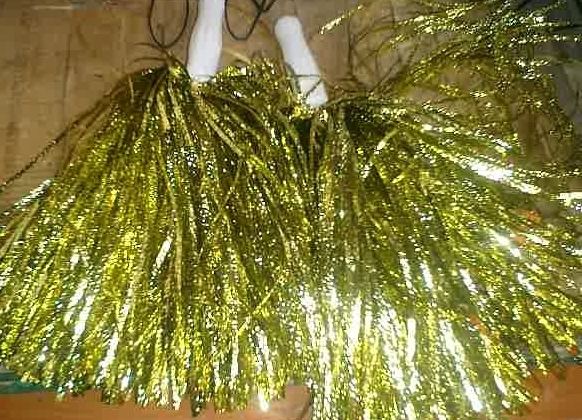 | ||
A pom-pom – also spelled pom-pon, pompom or pompon – is a decorative ball or tuft of fibrous material.
Contents
- Spelling and etymology
- Sports and cheerleading
- Clothing
- Roman Catholic clergy
- Toorie
- Flogger
- Toys and bicycles
- References
The term may refer to large tufts used by cheerleaders, or a small, tighter ball attached to the top of a hat, also known as a bobble or toorie.
Pom-poms may come in many colors, sizes, and varieties and are made from a wide array of materials, including wool, cotton, paper, plastic, and occasionally feathers. Pom-poms are shaken by cheerleaders, pom or dance teams, and sports fans during spectator sports.
Spelling and etymology
Pom-pom is derived from the French word pompon, which refers to a small decorative ball made of fabric or feathers. It also means an "ornamental round tuft" and originally refers to its use on a hat, or an "ornamental tuft; tuft-like flower head."
Sports and cheerleading
Cheerleaders use pom-poms at sports events for six reasons:
Most often, pom-poms are used in pairs (one in each hand), but this may vary with the particular requirements of the choreography of a dance or cheer.
Cheerleading pom-poms come in a variety of shapes, styles, colors, color combinations, and sizes. Shiny metallic pom-poms have become very popular in recent years.
Pom-poms are also waved by sports fans, primarily at college and high school sports events in the United States, Cheap, light-weight faux pom-poms in team colors are sometimes given or sold to spectators at such events.
Many schools and universities have dance teams in addition to their cheerleading groups. The dance teams may also use pom-poms occasionally, but many high school dance teams are now referred to as "Poms" squads. These squads are similar to drill teams, but usually have several routines that they strictly use pom-poms. Pom-poms have also come to be included in dance competitions in the United States. In many states, "Pom" or "Open Pom" is considered its own style of dance during competitions. For this style dancers use pom-poms and moves that are specifically choreographed to include pom-poms, but usually incorporate hip-hop and jazz choreography as well. When judging a routine in the Pom or Open Pom category, judges typically look for clean, sharp movements and complete synchronization of the team. These dances occasionally use different colored pom-poms and outfits to convey a theme and the dance team will create pictures from their pom-poms that relate to this theme.
Clothing
Small pom-poms may be used to adorn hats (such as Tam o' Shanters and some styles of the tuque), socks, fringed dresses, and other kinds of clothing.
Pom-poms form a conspicuous part of the uniform of French naval personnel, being sewn onto the crown of their round cap. Belgian sailors wear a light blue version.
Traditional Italian wedding shoes have small pom-poms, as do some Turkish dancing shoes.
Roman Catholic clergy
Roman Catholic clergy wear the biretta. The colour of its pom-pom denotes the wearer's rank. Priests wear a black biretta with a black pom. Protonotaries and domestic prelates (now prelates of honour) have a scarlet pom on their black birettas, and Papal Chamberlains (now Chaplains to His Holiness) wear a Roman purple pom on their black birettas.
Bishops and archbishops wear a Roman purple biretta with matching pom. The scarlet birettas of the cardinals have no pom, only a red loop. There is no papal biretta.
Some religious orders and congregations have unique birettas, such as the Norbertines who wear a white biretta with a white pom. Some St. Francis fathers wear a brown biretta with a black pom. Other orders may wear a black biretta with a white, green, or blue pom, or the black biretta of the secular priesthood.
Toorie
In reference to Scottish Highland dress and Scottish military uniforms, the small pom-pon on the crown of such hats as the Balmoral, the Glengarry, and the Tam o' Shanter is called a "toorie."
The toorie is generally made of yarn and is traditionally red on both Balmorals and Glengarries (although specific units have used other colours). It has evolved into the smaller pom-pom found on older-style golf caps and the button atop baseball caps.
Scots refer to any such hat decoration as a toorie, irrespective of the headgear.
Flogger
In Australia, the term "flogger" is sometimes used rather than "pom-pom". Floggers are very large, heavy pom-poms in the team's colours. They sometimes require more than one person to lift them, and they are waved about when a goal is scored.
Floggers are an important part of Australian rules football culture and cheer-squads.
Toys and bicycles
Pom-poms are sometimes used as children's toys. They are a common feature at the ends of the handlebars of children's tricycles and bicycles. They are also used in children's artistic crafts to add texture and color.
